All animals on the planet earth are born, develop (grow up), reproduce, and eventually die, meaning that they all have a life cycle. So, what are squirrel life cycles and stages? In this article, we’ll discuss in detail all the stages and what happens, for your understanding.
It might appear to be redundant for someone to care to know an animal’s life cycle. But believe me, it’s consequential. Animals are part of our lives and make our homes lively.
It’s no longer considered useless knowing how long your beautiful pet is going to live with you. Understanding your pet’s life cycle will allow you to give the necessary care at every stage.
Every single piece of information here is about what you need.
This article has been reviewed by Dr. Linda. Read more about our knowledge control process here.
Contents
Information About Squirrels
Squirrels are typically small mammals in the family Sciuridae and the order Rodentia. They are close cousins to mice and rats, which are also rodent species.
What captivates most people about squirrels is their long chubby bushy tails. They are medium-sized critters with tiny ears and large black eyes.
A squirrel’s fur is short, soft, and silky, and its thickness varies from species to species. Additionally, a squirrel’s fur ranges in color from one species to another and can be grey, white, brown, black, red, or yellow.
Squirrels possess ultra-sharp claws that enable them to grip on tree limbs firmly. This ability allows them to climb up and down the tree freely and cling on tree trunks/tree limbs using their hind legs. Their hindlegs are reversible.
Besides, these cuties have front teeth that never stop growing, a characteristic that is common among rodents. The teeth don’t wear out even if squirrels are continuously gnawing. Instead, continuous chewing helps to file down the teeth.
Something else to never forget is that squirrels exist in different species. We have Eastern grey squirrels, American red squirrels, flying squirrels, fox squirrels, and ground squirrels.
Squirrel Life Cycle And Stages
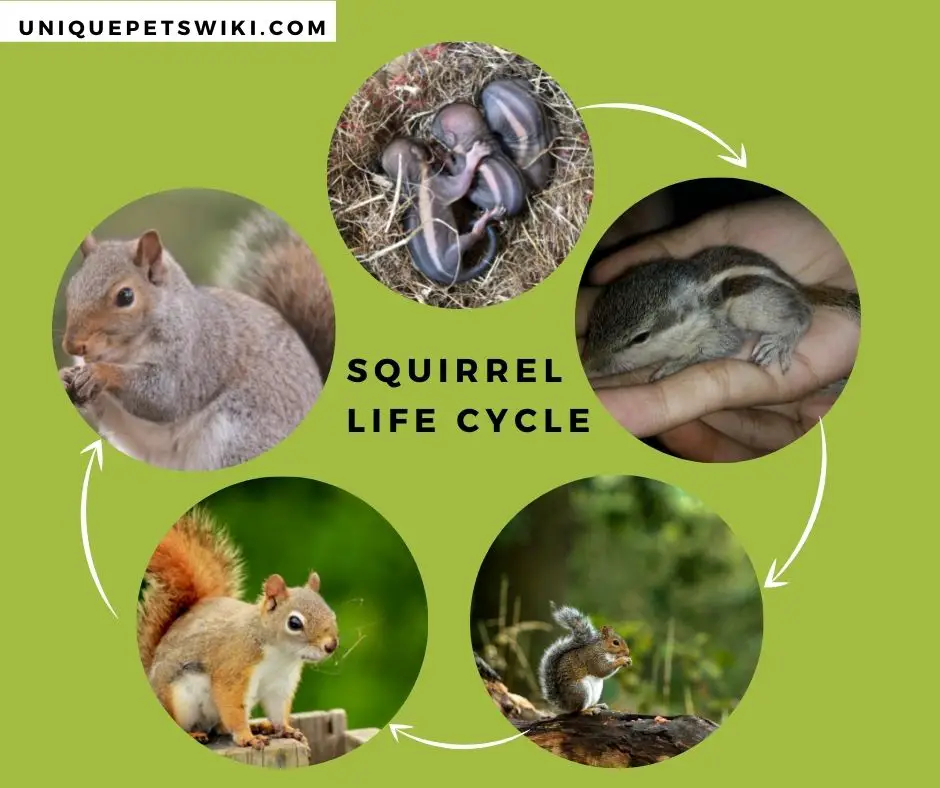
At the beginning of this article, I told you that there is no animal without a life cycle, including squirrels.
Of course, these rodents are born, they grow up, reproduce and die.
If there is no death, and we continue receiving new individuals, the world would get overcrowded and messy.
Back to our primary matter, what series of changes do squirrels pass through in their lives? Let’s find out below.
What is the Life Cycle of Squirrels?
A squirrel’s life cycle consists of five stages: newborn, baby squirrel, juvenile, subadult, and adult. Baby squirrels get all their needs from the mother.
Juvenile and adult squirrels are independent in everything. Baby squirrels enjoy each other’s company in the nest, but adults and juveniles live in individual nests.
The life of a squirrel here on earth begins when it’s born. Squirrels bring live babies through the natural birthing process.
We often see juvenile and adult squirrels scampering up and down the trees and sometimes stashing their food. They interact with each other outside their dwelling place when gathering food.
At Birth/Baby Squirrels
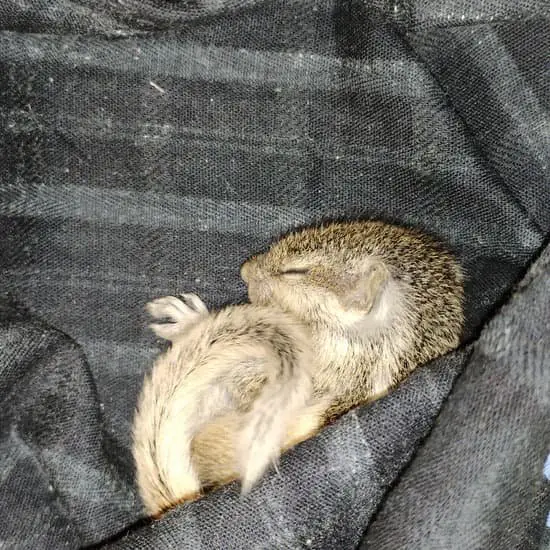
The mother squirrel carries a pregnancy anywhere from 23-65 days, depending on the species, and eventually delivers her babies. These newborns are without teeth and fur, and both their ears and eyes are closed at birth.
Moreover, the newborn squirrels (below five days old) are pink, and their fingers are joined. Above five days old, we no longer consider them to be newborns but young/baby squirrels. It’s from this age that the fur starts to develop slowly.
A baby squirrel between 8-10 weeks old has complete fur and takes the entire appearance of a mature squirrel, although they’re a bit small. The tail is entirely bushy, and its sharp teeth are full grown.
Juvenile Squirrels
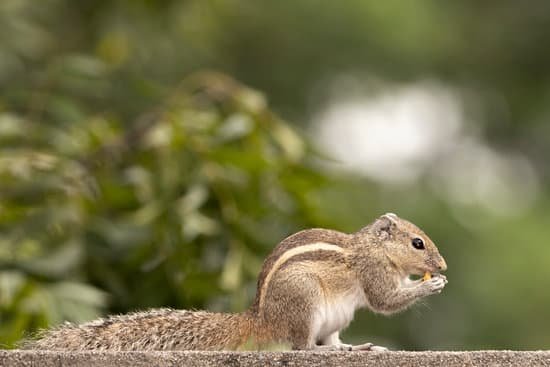
A juvenile squirrel is between ten weeks to six months old. Juvenile squirrels possess most features of subadult squirrels, and they’re miniature. They have sparse fur than subadult squirrels, and their tail’s hair is short and dense.
At 12 weeks, the young squirrel lives on its own, away from the mother’s nest, and gathers its food. A squirrel is considered juvenile until it is six months old, and then it graduates to the next age category.
You can quickly tell a juvenile squirrel by checking its teeth; its molars are not fully emerged. Both the babies and juveniles have extreme personalities, although they become gentler as they continue to grow.
Subadult Squirrels
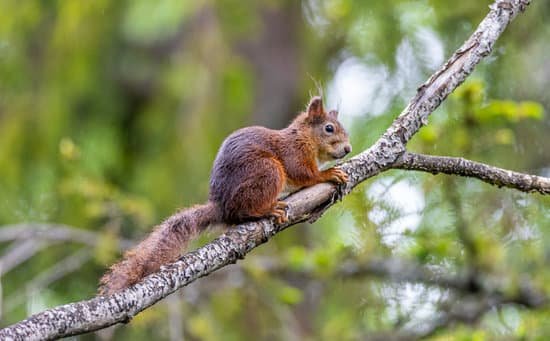
The subadult squirrels share most characteristics with the adults. If you compare a subadult and adult squirrel, you will notice that the former has sparse fur and are slightly small in size.
Subadult squirrels are sexually immature and are not ready for breeding. These squirrels are six months to one year old. Their fur has the same color as that of adults.
The subadults have all molars and premolars present, and there is no observable dentine.
Adult Squirrels
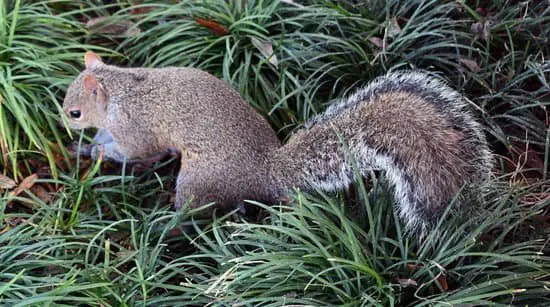
Squirrels that are above one year old are considered adults. An adult is sexually mature and can breed. These squirrels have dense fur both on the body and tail, and their sound tends to be pretty loud and noisy.
Adult squirrels have fully grown teeth and a well-pronounced gap between their molars and incisors. The gap allows them to gnaw with their front teeth (incisors) easily.
Adults aren’t as aggressive as their young ones. They are easy-going and tend to be very affectionate.
Adulthood: When Does the Squirrel Become an Adult?
Adulthood in squirrels is characterized by several features, including age, body length, weight, and personality.
According to age, squirrels are not adults until one year old. This is when the reproductive organs are fully developed, and they attain sexual maturity.
The typical body length of an adult squirrel is anywhere from 38-51 centimeters. The tail itself adds an extra length of about 15-25 centimeters to the squirrel’s size.
Adult squirrels typically weigh around 200-700 grams or more, although this differs with species. The weight may vary depending on the season, with winter recording the highest weights.
Additionally, adult squirrels have a mellow personality. They’re easy to approach and show affection to humans. These squirrels are fully covered with heavy fur that varies in color from one species to another.
Mating: When Do Squirrels Have Babies?
There are several squirrel species, such as flying squirrels, tree squirrels, and ground squirrels, and they all have newborns at different times of the year or in different seasons.
Most squirrels have their babies in early spring (Feb through Mar) and early summer (Aug. through Oct). Delivery happens after a female squirrel is pregnant for 23-65 days, depending on the species.
Most squirrel species mate twice a year, except a few species like the ground squirrels. The latter breeds only once a year.
The standard breeding season for most squirrels is between Dec through Feb and again in late June/Aug.
Mating Habits
Squirrels don’t follow the extravagant courtship procedures but indulge in an acrobatic mating chase until the winner emerges. The winning male is the one to engage in mating.
A male squirrel is capable of smelling a female entering into an estrus. After detecting such a female, the males gather near her nest and wait until she is receptive.
Once the female is ready for mating, she runs off, and the males start pursuing her. More often, the dominant male is lucky to find the female first and mate with her. Although any male can be the winner.
A female is on estrus for only a few hours. Mating happens from 1-25 minutes. A single female can mate with several partners for two days to several weeks.
Even if many males get the privilege to mate with the female, her kits are sired by a single male. The male that copulates with the female-first uses its penis to plug the female’s vagina with a non-seminal wax-like substance.
The plug acts as a barrier against the semen from other males that copulate with the female. Therefore, the kittens born belong to the first partner.
Breeding Season
The breeding season for each species of squirrels tends to vary. However, the majority of female squirrels enter into estrus at the beginning of every year.
A female squirrel is ready to reproduce after one year old and can mate once or twice each new year.
Males are always ready for mating, and they can mate many times per year. Also, one male can breed more than one female in a breeding season. Below is a list of the breeding season of different types of squirrels.
- Eastern gray: They breed twice every year, both in late winter or early spring and in the middle of summer.
- American red squirrels: This type of squirrel typically breeds in late winter and mid-summer.
- Fox Squirrels: Fox squirrels are fertile throughout the year, but they commonly mate in Dec through Feb and May/June.
- Flying Squirrels: Southern flying squirrels breed twice yearly, while Northern flying squirrels mate once. The mating for the latter happens between Mar and May.
- Ground Squirrels: These squirrels mate once yearly. Their breeding season occurs in the late spring.
The Gestation Period
Fox squirrels, flying squirrels, American red squirrels, and Eastern gray squirrels typically have a gestation period ranging between 33 and 44 days. On the other hand, ground squirrels gestate for 23-30 days.
Tropical and African squirrel species show a more extended gestation period. The females can go up to 65 days before delivering. How can you know that your squirrel is pregnant?
Well, a pregnant female squirrel appears to be fat and has swollen nipples. When in this condition, the female requires special care from its attendant. Make sure to feed her with quality foods and provide plenty of clean water.
Likewise, around ten days before the squirrel delivers, make sure to prepare its maternity nest. Line the nest with soft materials to provide a conducive place for the babies and the mother.
Childbearing – How Many Babies Can a Squirrel Have?
In the wild, birthing happens in the female’s nest, but you can provide a special place at home. An individual female can give birth to multiple kittens, and most species give birth to 2-5 kits.
However, some squirrels can deliver a much smaller or larger number of babies than the range indicated. How many babies a mother will produce correlates with the amount and quality of food she obtained before breeding as well as her genetics.
Exposing the female to high quality and quantity of foods before breeding increases conception rate and fecundity. Let’s see how many babies do different types of squirrels produce;
- Eastern gray: An Eastern gray squirrel mother has anywhere from 2-9 kittens in a single delivery.
- American red squirrel: These squirrels typically have 3-6 babies or more in one litter.
- Fox squirrels: Fox squirrels give birth to a litter consisting of 2-7 babies. They have two litters of babies yearly.
- Flying squirrels: A female flying squirrel has two births each year, and each litter contains 2-7 newborns.
- Ground squirrels: These are the most prolific breeders among squirrel species. A single litter will contain anywhere from 7-9 babies or even go up to 15.
Development of Baby Squirrels
Newborn baby squirrels are helpless creatures that need maximum care from the mother for survival. Initially, they are naked, blind, and have no teeth. A baby below five days old is entirely hairless and pink.
They have joined fingers, closed ears, and are small, around 20mm in size. Soft fur will start to emerge around the baby’s nose and mouth at five days old.
The skin starts to darken at one week as the fur continues to grow, and at two weeks, some sparse furs are evident. At this age, the eyes begin to open, and the ears start to move from the head.
You can see some teeth emerging at the baby’s lower jaw when it’s between 3-5 weeks, and the eyes are fully open. Also, the underbelly and most parts of the body have fur.
At 6-8 weeks, the babies can sit on their own and chew solid foods. This time, the baby looks like a squirrel in appearance, but it’s small.
When the baby is ten weeks old, its tail is bushy, and the body has a lot of fur. Weaning happens at this age, and the babies become independent. At ten weeks, the baby enters into a juvenile stage that lasts up to six months.
From six months to one year old, we have the subadult squirrels, and then at one-year plus, a squirrel is considered an adult.
How Long Do Squirrels Have the Average Lifespan?
It’s not a secret that the lifespan of wild and pet squirrels is highly variable. Pet squirrels have more extended longevity compared to wild squirrels.
Squirrels are lower in the food chain; therefore, wildlife attacks them for food. They are not only at risk of predation but also the harsh environment in the wild.
In contrast, pet squirrels receive everything they need and are protected from predators. That’s why wild squirrels have a reduced lifespan; they can die at any time. So, what is the average lifespan of squirrels?
In general, wild squirrels more or less have an average lifespan of 5-10 years. Depending on their care, pet squirrels can live for more than 15 years.
The oldest squirrel reported was 23 years and six months old at Wisconsin’s zoo in the United States.
Fun Facts About Squirrels
Squirrels are amazing animals to watch, and many people get attracted to them.
Squirrels have a lot more fun facts, besides being cute. Below are a few interesting facts about squirrels that will fascinate you.
Squirrels are Color Blind
Did you know that squirrels are color blind? These animals see everything in black, white, gray, yellow, and blue, but not red and green.
Squirrels cannot tell apart green and red colors or objects, making them color blind.
Squirrels Do not Mate with Other Types of Squirrels
An Eastern gray squirrel does not mate with an American red squirrel, nor does a northern flying squirrel mate with a Fox squirrel.
They rely on scents, sounds, sizes, and markings on their fur to help them know and mate with their kind.
Some Thoughts
To wrap up what we have learned, I want you to remember the following facts.
- Squirrel colors are incredibly different, and they range from grey, white, brown, black, red, or yellow.
- Squirrels are partially color blind. They cannot distinguish between red and green hues.
- Squirrels of different species do not mate with each other.
- Squirrels produce a large number of babies, usually between 2-5 kittens or more.
- Baby squirrels are blind, hairless, and toothless at birth and cannot walk.
- A female squirrel breeds once or twice yearly, while males are fertile throughout.
- Squirrels are pregnant anywhere from 23-44 days, and some African and tropical species reach up to 65 days.
